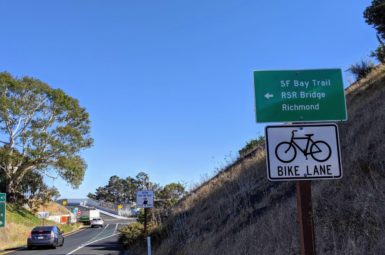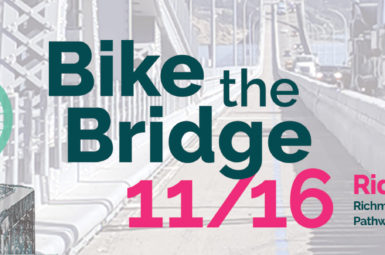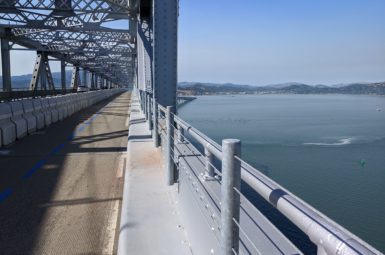Bike the Bridge | 11.16.19 Richmond-San Rafael Bridge Pathway: Decades in the Making
Bike the Bridge! After decades of advocacy from Marin County Bicycle Coalition, Bike East Bay, and SF Bay Trail, we’re delighted to announce that the Richmond-San Rafael Bridge multi-use pathway is now open! Head to our Richmond-San Rafael Bridge resource page for all things bridge-related, including route planning, news, and more!
At long last, the Richmond-San Rafael Bridge is set to open to people on foot and bike, with a ribbon-cutting ceremony planned for November 16!
“This is a truly historic moment for bicycling in the Bay Area,” said Tarrell Kullaway, Executive Director. “In addition to providing a new way to experience and connect with the Bay, this pathway showcases our commitment to healthy, sustainable transportation options.”
The pathway’s opening, which follows decades of advocacy from MCBC and others (more on this below), establishes the first-ever bicycle and pedestrian connection between Marin and Contra Costa Counties, closing a major gap in the 500-mile Bay Trail system.
“This new pathway unlocks countless new combinations of recreational rides, bike commutes, and shoreline hikes,” said Maureen Gaffney, Bay Trail Planner and former MCBC Board Director. “The proximity to ferries, buses, BART, and SMART on both sides of the bridge will have a wide variety of users planning creative treks in the months and years to come.”
The 10-foot wide pathway, which was approved as a four-year pilot project, runs on the bridge’s upper deck and is separated from traffic by a four-foot high moveable concrete barrier. The moveable barrier was included at Caltrans’ request in order to provide flexibility for maintenance needs.
Project History
The pathway opening follows two decades of advocacy from Marin County Bicycle Coalition, Bike East Bay, SF Bay Trail, and many others.
“We’re grateful to follow in the footsteps of the visionary advocates and leaders who dared to dream big and fought so hard to bring us to this point,” said Kullaway.
Bicycle and pedestrian access on the Richmond-San Rafael Bridge was first proposed in 1975, but thwarted when a severe drought required the construction of a pipeline along the former third lane. The pathway was later included in the 1989 Bay Trail Plan, which established the vision for a 500-mile pathway system along the Bay’s shorelines and bridges.
For decades, advocates, elected officials, and agencies tussled with Caltrans over bicycle and pedestrian access on the bridge. Caltrans resisted at every opportunity–even after three separate studies proved its feasibility–but advocates persisted. Finally, in 2016, the pathway was approved as part of a package of bridge improvements that included the addition of a third eastbound lane for automobile traffic on the lower deck.
If you talk to anyone involved in the project, they will tell you that this would not have happened if not for former MCBC Executive Director, National Safe Routes to Schools Partnership founder, and active transportation extraordinaire Deb Hubsmith, who championed and shepherded the project through bureaucratic and political hurdles for years.
“Deb’s passion and dogged determination on this project propelled all of our collective efforts,” said Gaffney.
Hubsmith tragically succumbed to leukemia in 2015, but, as evidenced by the pathway’s opening, her remarkable legacy continues to grow.
Third Lane Debate
Over recent years, some Transportation Authority of Marin (TAM) Commissioners have pushed back against the pathway’s round-the-clock schedule, arguing that the space should instead be used for automobile traffic during the morning commute on weekdays.
The issue has been oversimplified, with several key factors missing from the conversation:
-
Previous studies found that westbound backups are primarily attributed to the toll plaza.
-
Even if the lane is added, a bottleneck would occur where the road narrows to two lanes on the Marin side of the bridge. Fixing this bottleneck would require a major freeway widening project and several interchange improvements.
-
The moveable barrier system would likely take several hours each day to adjust and incur significant operational costs.
The Metropolitan Transportation Commission (MTC) is currently studying the feasibility and costs associated with a third westbound automobile lane. Any decisions about the pathway’s future ultimately lie with regional decision makers.
MCBC will continue to promote use of the bridge, advocate for improved connections in Marin, and remind our leaders why the pilot was approved in the first place.
“The pathway was approved as a four-year pilot and deserves every chance to succeed,” said Kullaway.
members make it happen
All of our work to make bicycling in Marin safe, fun, and accessible relies on your generous giving. Please support your bicycle coalition by making a one-time or recurring gift today!



